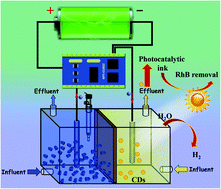The bioelectrochemical synthesis of high-quality carbon dots with strengthened electricity output and excellent catalytic performance†
Abstract
The emergence of microbial fuel cell (MFC) technology that can effectively recycle renewable energy from organic pollutants has been regarded as a promising and environmentally friendly route that could be widely used in numerous fields. Here, a novel sustainable self-energy conversion system was successfully constructed to renewably synthesize carbon dots (CDs) via in situ coupling with a MFC system. Interestingly, the generation of CDs was found to largely enhance the electricity production performance of the MFC. Low-temperature electron paramagnetic resonance (EPR) spectroscopic measurements and electrochemical characterization analysis results confirmed that the as-prepared CDs exhibited wide-conversion fluorescence properties and exposed carbon-rich active oxygen sites, and demonstrated a suitable band gap as well as excellent electrocatalytic performance. As a result, the prepared CDs possess high photo-bioelectrocatalytic activity for efficient H2 production, reaching 9.58 μmol h−1. Remarkably, CD-derived photocatalytic ink presented excellent contaminant elimination activity at the solid–solid interface. Thus, this work will provide a new platform for catalyst construction via a bio-assisted method towards the next generation of nano-photocatalytic inks for indoor contaminant removal.



 Please wait while we load your content...
Please wait while we load your content...